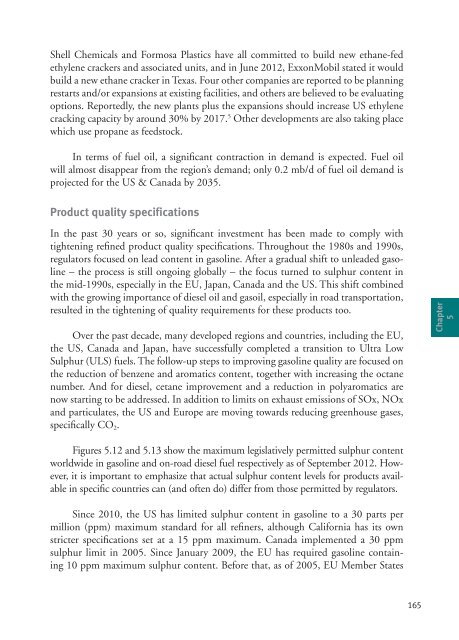World Oil Outlook - Opec
World Oil Outlook - Opec
World Oil Outlook - Opec
- TAGS
- world
- outlook
- opec
- www.opec.org
You also want an ePaper? Increase the reach of your titles
YUMPU automatically turns print PDFs into web optimized ePapers that Google loves.
Shell Chemicals and Formosa Plastics have all committed to build new ethane-fed<br />
ethylene crackers and associated units, and in June 2012, ExxonMobil stated it would<br />
build a new ethane cracker in Texas. Four other companies are reported to be planning<br />
restarts and/or expansions at existing facilities, and others are believed to be evaluating<br />
options. Reportedly, the new plants plus the expansions should increase US ethylene<br />
cracking capacity by around 30% by 2017. 5 Other developments are also taking place<br />
which use propane as feedstock.<br />
In terms of fuel oil, a significant contraction in demand is expected. Fuel oil<br />
will almost disappear from the region’s demand; only 0.2 mb/d of fuel oil demand is<br />
projected for the US & Canada by 2035.<br />
Product quality specifications<br />
In the past 30 years or so, significant investment has been made to comply with<br />
tightening refined product quality specifications. Throughout the 1980s and 1990s,<br />
regulators focused on lead content in gasoline. After a gradual shift to unleaded gasoline<br />
– the process is still ongoing globally – the focus turned to sulphur content in<br />
the mid-1990s, especially in the EU, Japan, Canada and the US. This shift combined<br />
with the growing importance of diesel oil and gasoil, especially in road transportation,<br />
resulted in the tightening of quality requirements for these products too.<br />
Over the past decade, many developed regions and countries, including the EU,<br />
the US, Canada and Japan, have successfully completed a transition to Ultra Low<br />
Sulphur (ULS) fuels. The follow-up steps to improving gasoline quality are focused on<br />
the reduction of benzene and aromatics content, together with increasing the octane<br />
number. And for diesel, cetane improvement and a reduction in polyaromatics are<br />
now starting to be addressed. In addition to limits on exhaust emissions of SOx, NOx<br />
and particulates, the US and Europe are moving towards reducing greenhouse gases,<br />
specifically CO 2.<br />
Figures 5.12 and 5.13 show the maximum legislatively permitted sulphur content<br />
worldwide in gasoline and on-road diesel fuel respectively as of September 2012. However,<br />
it is important to emphasize that actual sulphur content levels for products available<br />
in specific countries can (and often do) differ from those permitted by regulators.<br />
Since 2010, the US has limited sulphur content in gasoline to a 30 parts per<br />
million (ppm) maximum standard for all refiners, although California has its own<br />
stricter specifications set at a 15 ppm maximum. Canada implemented a 30 ppm<br />
sulphur limit in 2005. Since January 2009, the EU has required gasoline containing<br />
10 ppm maximum sulphur content. Before that, as of 2005, EU Member States<br />
165<br />
Chapter<br />
5
















